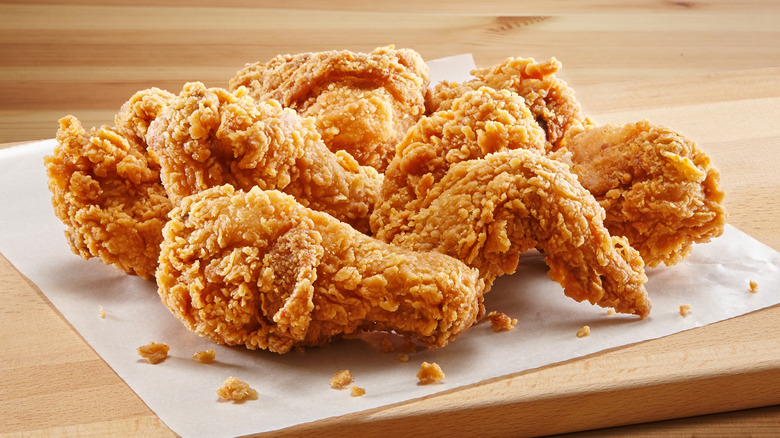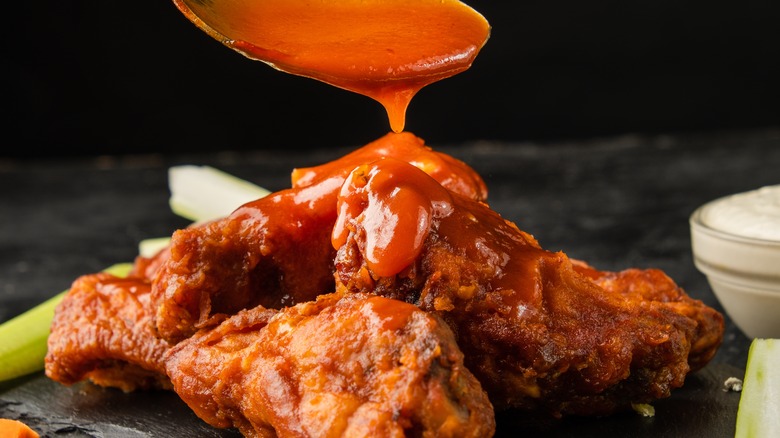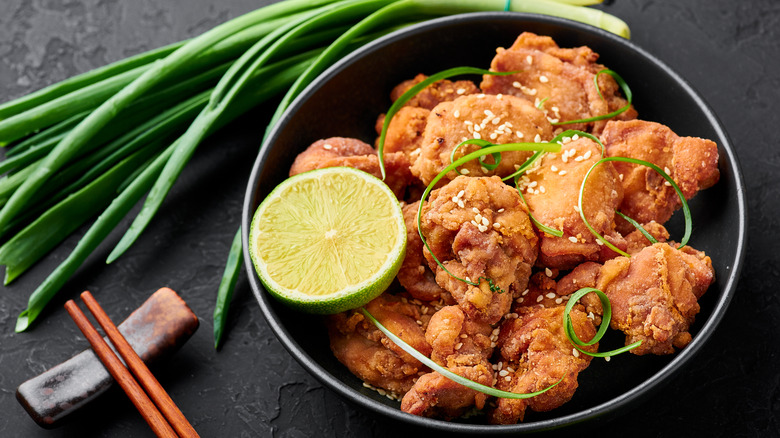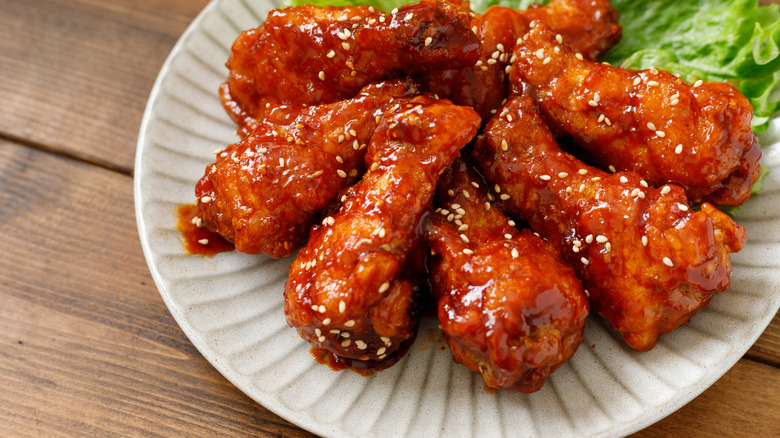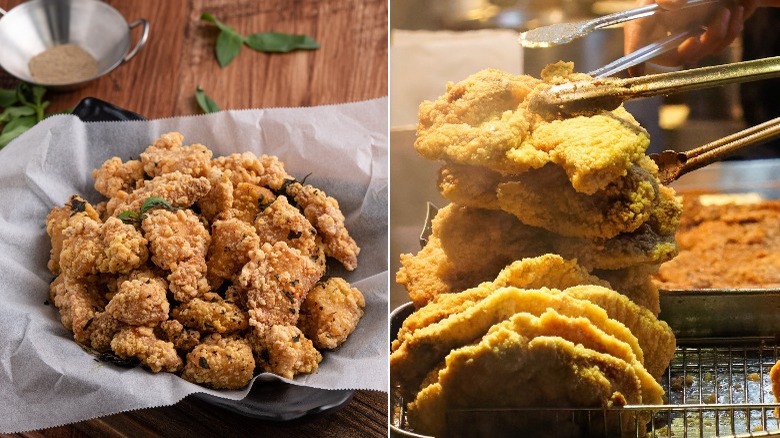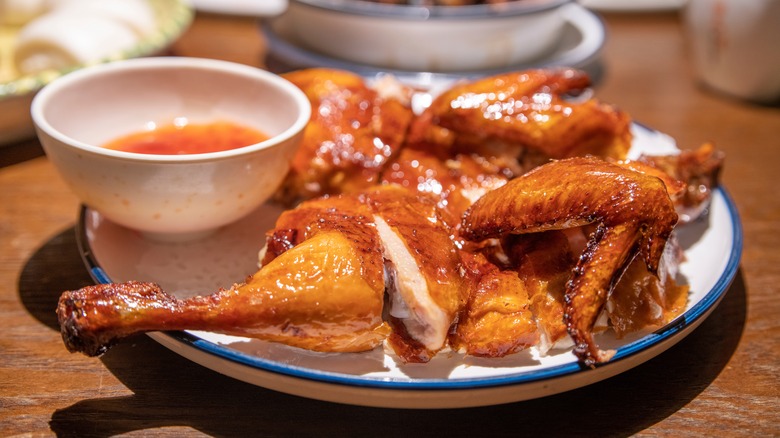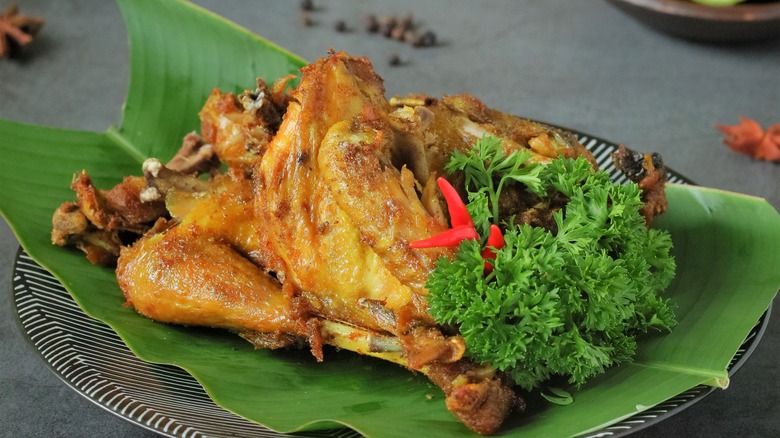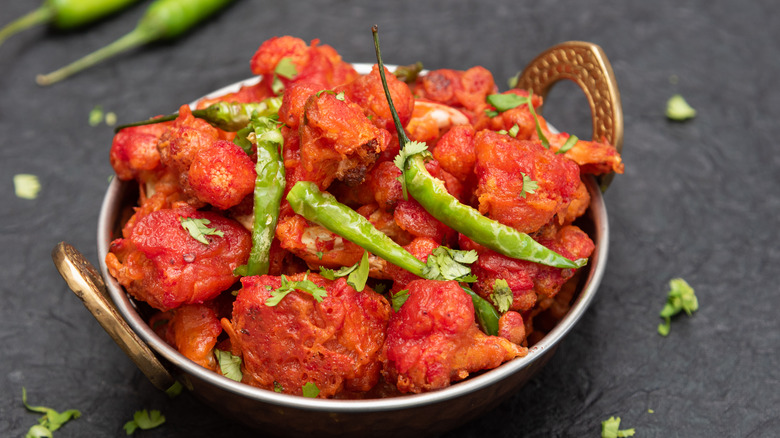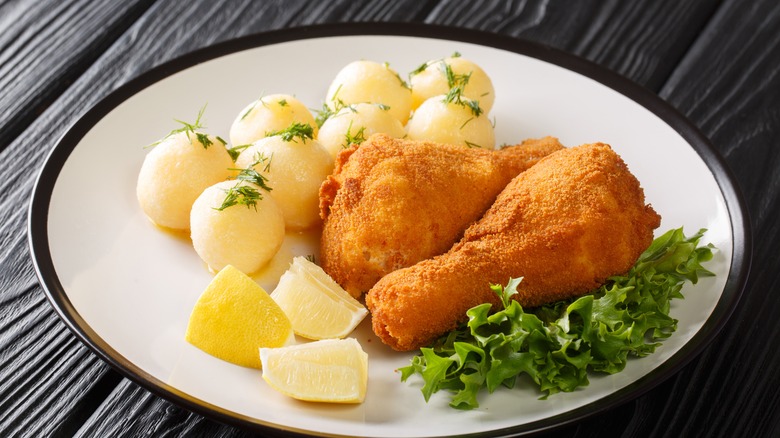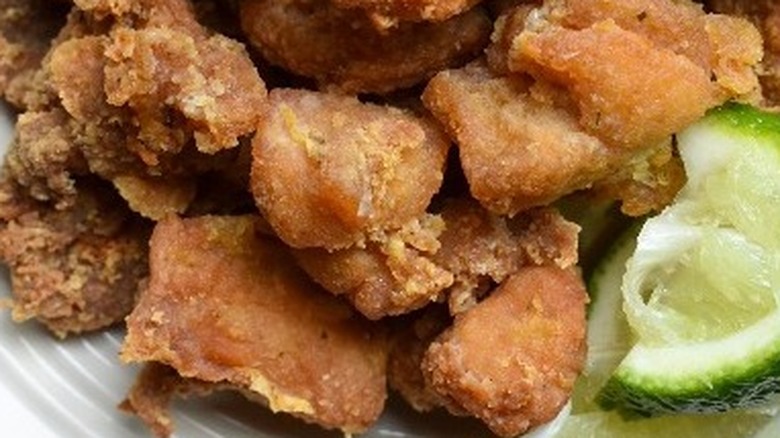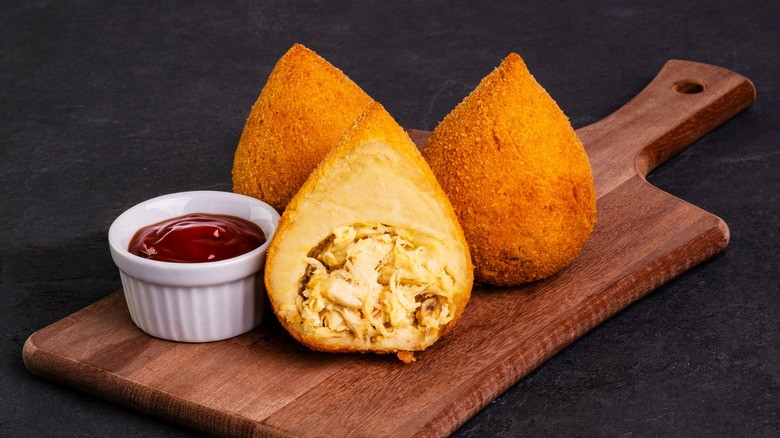13 Styles Of Fried Chicken Around The Globe
There's nothing quite like biting into a piece of hot, crunchy fried chicken. The satisfying crackle of sinking your teeth into the crisp skin to reach soft, tender meat dripping with savory juices is truly one of life's greatest pleasures. Add a dusting of special seasoning and a tangy dip or glaze, and the experience becomes nearly euphoric. Conjuring memories of summer picnics, community gatherings, and late-night cravings, fried chicken is a satisfying and nostalgic comfort food for many worldwide.
Across the globe, unique styles of fried chicken can be found in street corner stalls, fast food takeaways, and family dinner tables. Thankfully, there are home cooks, expat chefs, and even entire restaurant franchises devoted to the crispy poultry sharing both traditional and modern styles of the beloved dish across regions and borders. With so many ways to marinate and season, each country's signature style of fried chicken has evolved to reflect its distinct history, culture, and tastes.
Southern Fried Chicken, USA
Perhaps the most iconic style of fried chicken in the world, Southern fried chicken is a signature of the United States. Brined in buttermilk, the chicken tenderizes before being coated in seasoned flour, then fried crisp and golden brown. Traditionally, the chicken is broken down into breast, wings, and thighs for frying and is served in combinations of white and/or dark meat. From fast food chains to renowned soul restaurants, fried chicken is a beloved dish that speaks to the heart of Southern cooking.
Before it became a staple of drive-thrus and summer potlucks, fried chicken was reserved for special occasions and Sunday dinners. Appearing in recipe books older than the Constitution, the origin of Southern fried chicken is rooted in a complex history of immigration and slavery. In its Culinary Roots series, BBC Travel explores how the cooking method may have come with Scottish settlers to the New World. However, the dish is inextricably linked to African-American history and the dark chapter of slavery in the United States. Ark Republic explains that these ties likely began as slaveholders delegated the labor-intensive task of preparing fried chicken to Black women who mastered the technique and passed it down through generations where it was deemed "The Gospel Bird" due to its revered status and appearance on Sunday church dinners.
Despite a bitter legacy tied to slavery and racism, fried chicken remains a celebrated dish in communities across America that comforts and brings people together. Whether packed in a greasy takeout box, piled high on a tray at a family reunion, or lovingly made at home for a weekend dinner, Southern fried chicken is an icon of American cooking.
Buffalo Wings, USA
A staple of football tailgates and sports bars, Buffalo wings are a unique style of fried chicken born from a shipping mixup and a late-night craving. Buffalo-style Buffalo wings can make anyone's mouth water after being deep fried as they are. But what also adds to their uniqueness is a not-so-secret sauce concocted from red peppers, butter, and, you guessed it, hot sauce, which come together to form that iconic sauce you know as Buffalo sauce. Although countless variations and flavors of wings can be found at pubs and sports bars across the country, the original Buffalo wing holds a special place in the culinary history of the United States.
Like any good origin story, the tale comes in slightly different versions, but the basic facts remain the same. The Buffalo wing was invented by Teressa Bellissimo in 1964 at the Anchor Bar, a family-owned establishment in Buffalo, New York. Teressa's husband, Frank, recalled that the wings were an invention born from necessity as the bar had accidentally received a shipment of wings rather than the usual selection of other chicken parts. Her son, Dominic, claimed that the tangy wings served with blue cheese and celery were created to satisfy a late-night craving after a night of drinking with friends. Before long, the zesty chicken wings had taken off, appearing on menus across the country and inspiring numerous festivals, contests, and celebrations. Since 1977, the city of Buffalo has celebrated its annual Chicken Wing Day on July 29th in honor of the eponymous dish.
Karaage, Japan
From tempura to katsu, Japan is well-known for its love of fried foods, especially karaage, a cozy dish commonly found in izakaya restaurants throughout the country. Karaage is made using bite-size pieces of chicken thighs marinated in soy sauce, sake, mirin, and seasoning to tenderize the meat. The pieces are then coated in wheat flour or potato starch, deep fried, and served with kewpie mayonnaise and lemon (via Japan Experience). An official karaage association in Japan issues standards and ratings to restaurants that serve the dish and declared the city of Nakatsu to be one of the best places to enjoy the beloved food (via Washington Post).
Karaage is a versatile style of fried chicken eaten on its own as street food, on top of a hearty rice bowl, or enjoyed alongside a cold beer. The crisp, tender chicken pieces appeal to both kids and adults alike and can be found in school lunches and on bar menus, conjuring childhood nostalgia and memories of good times in the company of friends.
Yangnyeom-chicken, South Korea
As K-Pop and Korean dramas have made their way onto the world stage, so has the crunchy, sticky, and sweet Korean fried chicken. Sometimes referred to as the other KFC, Korean fried chicken has become widely popular both in and outside Korea. With a range of variations appearing at the numerous fried chicken eateries across Korea and popping up around the world, the most popular remains yangnyeom-chicken, seasoned and fried chicken pieces with a thin, crispy crust slathered in a tangy, sweet, and spicy sauce (via CNN Travel). To make yangnyeom-chicken, chicken pieces are battered in flour and potato starch, fried twice, and drenched in a red, garlicky sauce made with ketchup, spices, and gochujang, a fermented red chili paste often used in Korean cooking.
Although many countries enjoy fried chicken with a cold beer, South Korea takes this iconic pairing to the next level, making it a national pastime. Chimaek, a phrase combining the Korean words for chicken and beer, refers to this cultural phenomenon of eating fried chicken accompanied by beer as a way to relax and gather with friends. Chimaek continues to grow as a unique part of Korean drinking and dining culture.
Yan Su Ji and Da Ji Pai, Taiwan
Fried chicken is a street food favorite across many cultures, but nowhere is this more evident than in Taiwan's bustling roadside shops and night markets. Yan su ji is a bite-sized fried chicken snack that gained popularity around the 1970s and can be found amidst the crowded stalls of these highly-trafficked gathering spots. Westernized as popcorn chicken, yan su ji are small chicken pieces marinated in spices and rice wine, then coated in sweet potato starch before frying. The dish is finished with a dusting of five spice powder, Szechuan pepper, chili powder, fried basil leaves, or bits of fried garlic. This style of Taiwanese fried chicken is typically served in paper bags for easy snacking without messy dips or sauces (via NY Times).
Fried chicken is so beloved in Taiwan that it is known for not one but two fried chicken street foods. Da ji pai is a massive fried chicken cutlet also popular at night markets in Taiwan, Hong Kong, and Malaysia that rose to prominence in the 1990s. To make da ji pai, chicken breasts are butterflied and pounded flat before marinating in wine and spices. The huge chicken pieces are breaded in flour or sweet potato starch before frying to a crisp, golden brown. Like yan su ji, da ji pai is also finished with a sprinkling of five spice powder or Szechuan pepper.
Cantonese Crispy Chicken, China
A vast departure from General Tso's or sweet and sour chicken, both popular on Chinese takeout menus in the United States, Cantonese-style chicken is a traditional fried chicken dish with a unique preparation method and flavor profile. This style of fried chicken, often reserved for holidays and special occasions due to its elaborate process, is renowned for its balance and contrast of flavors and textures.
Making style of fried chicken takes several hours, but is totally worth it in the end. Typically, you first steam the chicken, then let it dry over a few hours. Once the chicken has dried, it is ready for deep-frying, rotating the chicken as needed to achieve an even, golden crust, which is only then enhanced by the sugar sprinkled on top and the vinegar drizzled over it. It's a delicious Chinese dish we keep coming back to for a reason.
Ayam Goreng, Indonesia and Malaysia
Ayam goreng literally translates to "fried chicken" in both Indonesian and Malay and is a popular street food dish found across the region. Believed to originate during the mid-20th century, the dish has since become an icon of Indonesian and Malaysian cuisines (via 196 Flavors). This style of fried chicken is unique in its preparation as it is marinated and pre-cooked in an aromatic broth before frying. To prepare ayam goreng, a paste is made with fresh shallots, garlic, galangal, turmeric, coriander seeds, sugar, and tamarind paste, although regional variations may include different combinations of spices. The chicken is braised in a broth made with the fragrant paste, lemongrass, and Indonesian bay leaves from which the dish gets its signature color and texture. The skin picks up a golden tint from the turmeric, and the flesh of the chicken is left flavorful and soft. After cooking in the broth, the chicken is fried to attain a crunchy exterior and served with lime and a chili paste called sambal.
Ayam goreng is somewhat of a blanket term for fried chicken with a wide variety of regional versions featuring different ingredients and seasonings with slightly different preparations. For example, some versions cook the chicken in coconut milk or coconut water instead of plain water or broth. The Javanese version includes coating the chicken in coarse breadcrumbs before frying to give it a unique, crispy texture. Variations of ayam goreng are often enjoyed on their own or accompanied by rice and vegetables.
Chicken 65, India
Although the recipe for chicken 65 is generally recognized as a creation of A.M. Buhari for the Buhari Hotel in 1965, myths and misconceptions about the dish's origin continue to circulate. Times of India explores the story behind the iconic dish and how it got its name with theories ranging from the chicken being cut into 65 pieces or marinated for 65 days to appearing as the 65th item on a menu or having 65 ingredients. In reality, this signature style of fried chicken was named for the year of its invention, 1965, and has been followed up with other, less popular versions, including chicken 72, 82, and 90.
Showcasing the distinct flavor profile of South Indian cuisine, Chicken 65 is made by marinating pieces of boneless chicken in spices and yogurt, then dusting them in rice flour before deep frying. The dish is dressed with a mixture of green chilies, minced garlic, and curry leaves. Since its creation, chicken 65 has become widely recognized and can often be found on menus at Indian restaurants in the United States and around the world.
Chicken Kiev, Ukraine and Russia
Served to dignitaries in Moscow and as frozen convenience food, chicken Kiev assumed many identities in its time. Made by pounding a breast filet flat and rolling it around cold butter, the chicken is coated with egg and breadcrumbs, then fried. The origin of this style of fried chicken is tangled in a murky history of politics and disagreements over its ownership. NPR teases out the winding story of the eastern European comfort food from its roots in French cuisine to disputed versions across Europe and the United States.
Although its ownership is debated, chicken Kiev has distinctive ties to French cooking. During the 19th century, Russian aristocracy became fascinated with French cuisine and often sent chefs to Paris for training. A French dish, suprême de poulet, is a suspected forerunner of the Russian version known as Mikhailovska cutlet. The Parisian dish was made with veal, but Russian chefs used chicken, a delicacy at the time. The dish rose in popularity and was eventually served to leaders of the Soviet Union at state dinners. In the years following WWII, the dish began to appear at restaurants in New York where it was renamed chicken Kiev, perhaps to attract Russian and Ukrainian immigrants. Chicken Kiev made its way back to Europe where different preparations continued to cause dissent. Ukrainian chefs made it simply, stuffed with only butter, decrying the Russian addition of cheese or garlic and parsley by the Americans and British. Peaking in the mid-20th century, chicken Kiev fell from fashion, relegated to the freezer aisle. However, the storied dish has seen a resurgence with modern takes appearing on menus across Europe.
Backhendl, Austria
Similar to German schnitzel, which is traditionally made with veal, Austria's take on fried chicken is a classic dish once reserved for the upper class (via Perceptive Travel). A Viennese specialty since the 18th century, backhendl is made by rubbing a small chicken with lemon juice and seasonings which are then cut into pieces and either left whole or sometimes deboned and flattened. The pieces are dipped in egg wash and flour, then coated in breadcrumbs and fried. In its original form, the dish was often served with fried offal, including chicken heart and liver. Modern versions of backhendl are typically accompanied by lemon wedges, fried parsley leaves, and Austrian potato salad (via Taste Atlas). With Austria's central location in Europe, the dish goes by a number of different names across nearby countries, including backhuhn or backhähnchen in Germany, poulet frit a la Viennoise in French-speaking regions, or Viennese fried chicken in English. Backhendl is a popular dish in neighboring Germany and can often be found at Oktoberfest celebrations in Munich.
Pollo Fritto, Italy
A popular dish from Tuscany and enjoyed all across Italy, pollo fritto consists of chicken pieces marinated in olive oil, lemon juice, and herbs dipped in batter and deep fried. The dish is seasoned simply with salt and served with lemon slices and parsley (via Taste Atlas). A similar version of the dish is often served in Jewish-Italian households at Hanukkah, adding nutmeg to the seasoning blend. In her book, The New Mediterranean Jewish Table, Joyce Goldstein describes the special meaning behind this holiday dish.
Jewish cooking traditions hold a significant place alongside traditional Italian techniques in the culinary history of Italy. Because Hanukkah commemorates the oil miraculously keeping the menorah lit for eight days, fried foods play a central role in the celebration. In addition to pollo fritto, fried dishes served by Italian Jews at Hanukkah include carciofi alla Giuda, which is the most well-known and consists of crispy, fried artichokes; torzelli, a deep-fried curly endive; fritto misto, a mixed fry and may include an assortment of fish or vegetables; and frittelle di zucca or squash fritters popular in the Veneto region of Northern Italy (via NPR).
Chicharrón de Pollo, Dominican Republic, Puerto Rico and Cuba
Frequently found at beachside stands in the Dominican Republic as well as restaurants and food stalls in Puerto Rico and Cuba, chicharron de pollo is a simple pleasure. Chicken, usually the thigh meat, is deboned and cut into small pieces with the skin still on. The chicken pieces are marinated, dredged in seasoned flour, and fried, then served simply with lime wedges. With the skin intact, an air pocket is created between the flesh and the skin, allowing for a light, crunchy texture. Dominican Cooking describes how the dish has evolved over time with different versions, including marinades of soy sauce and rum, a coating of cracker crumbs, or seasoned with paprika. Variations of this dish are popular throughout the Caribbean and can be found in parts of Central and South America seasoned or marinated in citrus juice, garlic, soy sauce, black pepper, or rum.
Coxinha, Brazil
One of the most popular street foods in Brazil, coxinha is an unforgettable fried chicken treat made with chicken thighs served in the shape of a drumstick. Created to appease the whims of a little prince, according to legend, coxinha means "little thigh," referring to both the meat and the shape of the dish. Made in two parts, the pastry and the filling, coxinhas are more similar to croquettes than traditional styles of fried chicken. However, this salgado, or savory appetizer, is so popular that it would be remiss to exclude it. To make the pastry, chicken broth is mixed with butter, flour, potato, or cassava. Shredded chicken thighs are mixed with onion, garlic, herbs, and a soft local cheese called catupiry to create the filling. The pastry is filled and shaped, then battered in egg and coated in breadcrumbs before frying. Coxinha is often enjoyed with a Brazilian vinaigrette, hot sauce, or ketchup (via Taste Atlas).
Although they can now be found throughout Brazil, one version of the coxinha's origin story begins with royalty. As the story goes, the son of Isabel, Princess Imperial of Brazil, loved to eat chicken drumsticks. But one day, the cook ran out and decided to transform a whole chicken into the shape of a drumstick made of dough and pieces of chicken to appease the young prince, creating the beloved snack (via Nobility). An alternative story suggests the dish was invented in São Paulo as a cheap and durable snack for the working class. Regardless of which story is true, in Brazil, coxinha is a unique style of fried chicken that is beloved by all.

